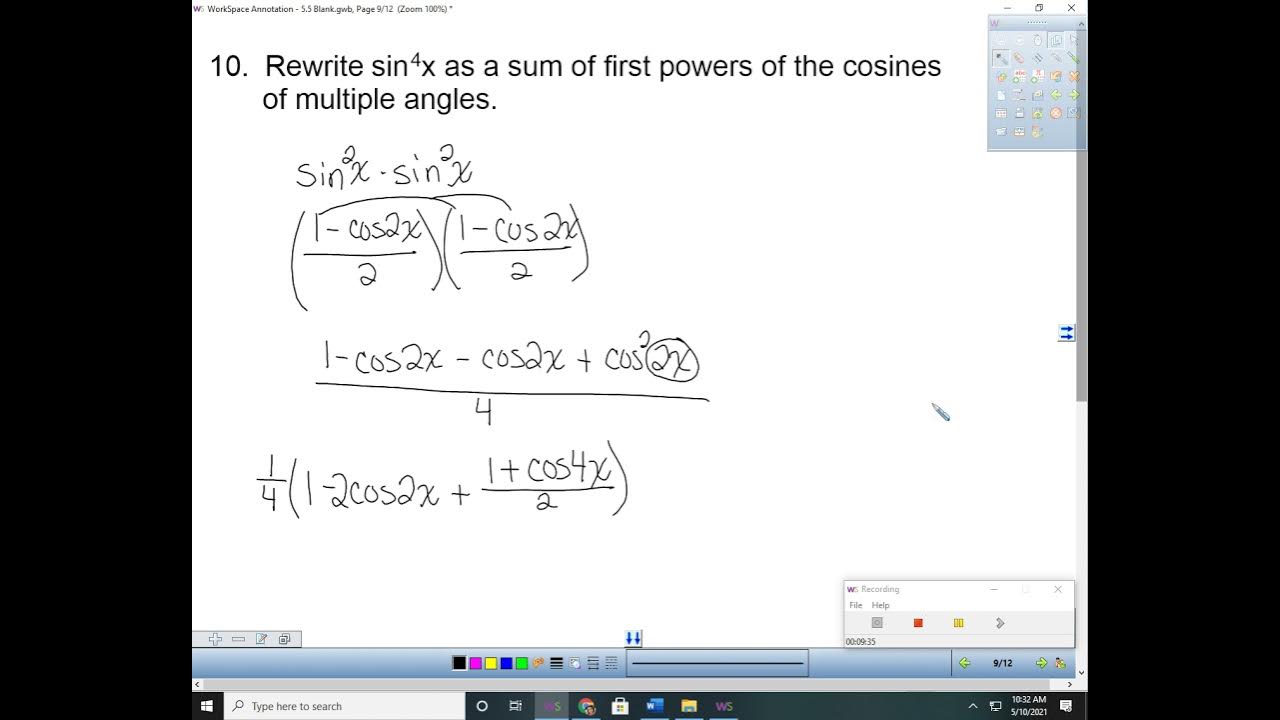Inverse Trig Functions With Double Angle Formulas and Half Angle Identities - Trigonometry
TLDRThis transcript explores trigonometric identities and their applications through various problems. It delves into the concept of sine and cosine of double angles, using the double angle formula to find sine of 2θ, where θ is the arc cosine of 4/5. The script also covers finding cosine of 2θ for arctan(-12/5) and tangent of 2θ for arc cosine(-8/17), illustrating the process with right triangles and simplifying expressions. It further explains the half-angle formula to find cosine squared and sine squared for specific angles, providing step-by-step solutions and emphasizing the importance of understanding trigonometric functions and their relationships.
Takeaways
- 📚 The script discusses trigonometric identities and functions, specifically focusing on sine, cosine, and tangent in relation to angles.
- 🔍 It emphasizes the importance of understanding that arcsine, arccosine, and arctangent are functions that return an angle, not a value.
- 📐 The script uses the double angle formula to find the sine of twice an angle, demonstrating the process with an example involving arccosine.
- 📈 The example of sine of two times arccosine of 4/5 is worked through, showing how to use the double angle formula and right triangle properties.
- 👉 The cosine of a right triangle in quadrant one is found by using the 3-4-5 triangle analogy, leading to the calculation of sine and cosine values.
- 🧩 The script introduces the concept of simplifying expressions involving trigonometric functions of angles, such as cosine of two times arctangent.
- 📉 The process of finding the cosine of two times arctangent of -12/5 involves drawing a right triangle in quadrant four and using the Pythagorean theorem.
- 📶 The tangent of two times arccosine of -8/17 is calculated, demonstrating the use of the tangent formula and the properties of a right triangle in quadrant two.
- 🔢 The script explains how to use the half-angle formula to find cosine squared of half an angle, using the example of arc sine of 4/5.
- 🔑 The power reducing formula is introduced as an alternative method to find cosine squared of half an angle, simplifying the process.
- 📝 The final examples involve simplifying expressions like sine squared of half arc cosine of 7/25, showcasing the use of trigonometric identities and simplification techniques.
Q & A
What is the value of sine when given the arc cosine of 4/5?
-The sine of two times the angle theta, where theta is the arc cosine of 4/5, can be found using the double angle formula: 2 * sin(theta) * cos(theta). Since cos(theta) = 4/5, and using the 3-4-5 right triangle, sin(theta) = 3/5, the final answer is 24/25.
How do you find the cosine of two times the arctangent of -12/5?
-First, identify the triangle in quadrant four with tangent as -12/5, leading to a 5-12-13 right triangle. Then use the double angle formula for cosine, cos(2theta) = cos^2(theta) - sin^2(theta), with sin(theta) = -12/13 and cos(theta) = 5/13, to find the result as -119/169.
What is the tangent of two times the arc cosine of -8/17?
-For theta as arc cosine of -8/17, which is in quadrant two, use the 8-15-17 right triangle to find tan(theta) = 15/(-8). Then apply the formula for tan(2theta) = 2*tan(theta) / (1 - tan^2(theta)) to get the final answer as 240/161.
How do you calculate the cosine squared of half the angle given by arc sine of 4/5?
-Since theta is arc sine of 4/5, sin(theta) = 4/5, and cos(theta) = 3/5. Use the power reducing formula, cos^2(theta/2) = (1 + cos(theta))/2, and substitute the known values to get the result as 4/5.
What is the sine squared of half the angle given by arc cosine of 7/25?
-For theta as arc cosine of 7/25, use the formula sin^2(theta/2) = (1 - cos(theta))/2, with cos(theta) = 7/25, to find the result as 9/25.
What is the significance of the double angle formula in trigonometry?
-The double angle formula is used to find the trigonometric value of an angle that is twice the original angle. It simplifies the process by relating the trigonometric functions of the original angle to those of the double angle.
Why is it important to know the quadrant when dealing with arc cosine and arc tangent values?
-Knowing the quadrant is crucial because it determines the sign of the trigonometric functions. For example, arc cosine is positive in quadrant one and negative in quadrant two, while arc tangent is positive in quadrants one and four.
How does the 3-4-5 right triangle help in finding the sine of an angle given by arc cosine of 4/5?
-The 3-4-5 right triangle provides the lengths of the sides needed to find the sine value. If cos(theta) = 4/5, then the triangle's sides are proportional to 3, 4, and 5, with sin(theta) being the opposite side over the hypotenuse, which is 3/5.
What is the process for finding the cosine of two times the arctangent of a negative value?
-First, determine the quadrant based on the negative value (quadrant four for arctan). Then, draw the right triangle, find the lengths of the sides, calculate sin(theta) and cos(theta), and finally use the double angle formula for cosine to find the result.
Can you use the power reducing formula for cosine squared of half an angle without knowing the triangle's sides?
-No, the power reducing formula for cosine squared of half an angle, cos^2(theta/2) = (1 + cos(theta))/2, requires you to know the value of cos(theta) beforehand, which might need the sides of the triangle to calculate.
Why is it necessary to simplify the final answer in trigonometric problems?
-Simplifying the final answer ensures that the result is in its most reduced and understandable form, making it easier for others to verify and use in further calculations.
Outlines
📚 Understanding Trigonometric Functions and Double Angle Formulas
This paragraph introduces the concept of trigonometric functions and their inverses, focusing on sine and cosine. The script explains how to interpret arc sine and arc cosine as angles and how to apply the double angle formula for sine. It walks through an example calculating sine of two times an angle where the angle is derived from the arc cosine of 4/5. The explanation includes constructing a right triangle in quadrant one, identifying the sides, and using the double angle formula to find the sine of the double angle. The paragraph also challenges the viewer with a problem involving cosine of two times an arctangent of a negative value.
🔍 Calculating Trigonometric Values Using Right Triangles
The second paragraph delves into the process of finding tangent and cosine values for double angles, using the double angle formulas. It begins by identifying the angle from an arc cosine value and constructing a right triangle in quadrant two. The script explains how to find the tangent of the angle using the sides of the triangle and then applies the double angle formula for tangent to find the value of tangent of two times the angle. The paragraph also covers a problem involving cosine squared of half an angle, where the angle is derived from an arc sine value. It uses the half angle formula to find the cosine squared of half the angle, providing a step-by-step calculation.
📈 Applying Power Reducing and Half Angle Formulas in Trigonometry
In the final paragraph, the script continues to explore trigonometric calculations, specifically focusing on power reducing and half angle formulas. It demonstrates how to find sine squared of half an angle when the angle is given by an arc cosine value. The explanation involves using the identity for sine squared theta and applying the half angle formula to find the sine squared of half theta. The paragraph provides a detailed calculation, multiplying the numerator and denominator by the appropriate values to simplify the expression and arrive at the final answer. Additionally, it offers guidance on how to use a calculator to find the trigonometric values and presents both the fraction and decimal form of the final answer.
Mindmap
Keywords
💡Sine
💡Arc Cosine
💡Double Angle Formula
💡Right Triangle
💡Hypotenuse
💡Arc Tangent
💡Quadrants
💡Cosine
💡Tangent
💡Half-Angle Formula
Highlights
Introduction to trigonometric identities and their applications.
Explanation of sine as a value and arc sine as an angle.
Clarification on the meaning of arc cosine and its relationship to angles.
Use of the double angle formula to find sine of two times an angle.
Demonstration of finding the missing side of a right triangle using arc cosine.
Calculation of sine theta using the properties of a 3-4-5 right triangle.
Application of the double angle formula to evaluate sine two theta.
Simplification of cosine of two times an arctangent.
Construction of a right triangle in quadrant four for negative arctangent.
Finding sine and cosine of a right triangle using tangent.
Utilization of the double angle formula for cosine 2 theta.
Solving for tangent of two times an arc cosine using the tangent formula.
Identification of the right triangle for arc cosine in quadrant two.
Calculation of cosine squared of half an angle using the half angle formula.
Explanation of the power reducing formula for cosine squared theta.
Final simplification of the expression to four over five.
Solving sine squared of half an arc cosine using the sine squared formula.
Final simplification of the expression to nine over twenty-five.
Instruction on how to use a calculator to find the final answer.
Transcripts
Browse More Related Video

Verifying Trigonometric Identities With Double Angle Formulas

How to Use the Double and Half Angle Formulas for Trigonometry (Precalculus - Trigonometry 28)

Trig Identities

Ultimate trig identity problem study guide!

5.5 Multiple Angle and Product to Sum Formulas (Part 2)

Right Triangle Trigonometry and Half Angle Identities & Formulas
5.0 / 5 (0 votes)
Thanks for rating: